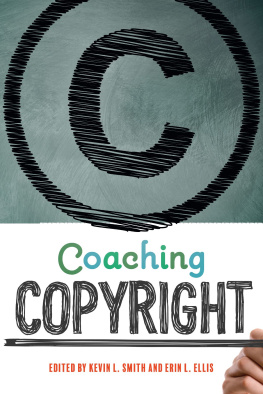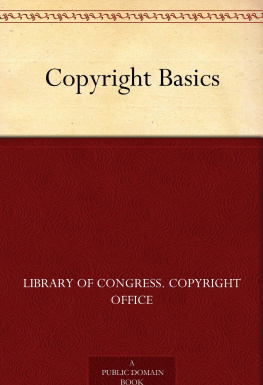The Copyright Book
The Copyright Book
A Practical Guide
Sixth Edition
William S. Strong
The MIT Press
Cambridge, Massachusetts
London, England
2014 Massachusetts Institute of Technology
All rights reserved. No part of this book may be reproduced in any form by any electronic or mechanical means (including photocopying, recording, or information storage and retrieval) without permission in writing from the publisher.
Library of Congress Cataloging-in-Publication Data
Strong, William S.
The copyright book : a practical guide / William S. Strong. SixthEdition.
p. cm.
Includes bibliographical references and index.
ISBN 978-0-262-02739-7 (hardcover : alk. paper)
ISBN 978-0-262-32351-2 (retail e-book)
1. CopyrightUnited States. I. Title.
KF2994.S75 2014
2013038918
In memory of my parents
Preface
At their best, our laws embody our deepest assumptions about human beings and what proper relations among human beings ought to be. Copyright is such a law. It springs from the belief that those who try to contribute to our always inadequate store of information and inspiration ought to be paid for their pains. This seems a very creditable attitude.
My purpose in writing this book has been to make available to people whose lives and work are affected by the laws of copyright an understanding of their rights and responsibilities. However, I hope that in doing so I have also managed to communicate some of my own fascination with the subject.
I have found it useful to write much of this book as though from the standpoint of the creator of a workbe it a novel, a painting, a blueprint, a dance. But whatever is not kept safe for the artist is given to the public; if you are a would-be user of an artistic or other creative work, you will know your boundaries by the boundaries drawn for the creator of it.
I have tried to gather material and organize it in a way that will tell the story simply. This has not proved possible in all respects; parts of the law are so complex that no amount of pruning and rearranging could make them any less dense. Nor has it proved possible at every point to avoid technical language and terms whose legal definition differs from their ordinary meaning. In such places I have given examples to try to make clear what is being said.
Two further comments about organization are in order. First, because the copyright law that went into effect on January 1, 1978, governs all works created after 1977 and many aspects of works created earlier, I have used this law as my guide for most of the book. If you are concerned with pre-1978 works, you should be sure to read , which deals with these works. Second, although many rules differ from one art form to another, it became apparent that to deal with various art forms individually would create a great deal of needless repetition. Instead, therefore, I have treated the various aspects of the law as units and within each unit discussed the exceptions pertaining to one art form or another.
Space does not permit me to acknowledge adequately the encouragement that family and friends have given me to write and later revise this book. In earlier editions I gave special thanks to two people, Evie Hanlon and Michelle Kincade, who had given new meaning to the word secretary and without whom all encouragement would have been in vain. But times change, and, like most people blessed with the curse of modern technology, I have become my own amanuensis. The focus of my gratitude therefore shifts to my wife Ann, who has put up with many a foregone evening and weekend to enable this sixth edition to see the light of day. I am grateful to her for so many things, though, that this (which would otherwise be enormous) is but a drop in the bucket.
1 The Subject Matter of Copyright
Copyright law is essentially a system of property. Like property in land, you can sell it, leave it to your heirs, donate it, or lease it under any sort of conditions; you can divide it into separate parts; you can protect it from almost every kind of trespass. Also like property in land, copyrights can be subjected to certain kinds of public use that are considered to be in the public interest. I shall explain these various aspects of copyright property through the course of this book.
The province of copyright is communication. It does not deal with machines or processesthose are governed by patent lawthough it has been stretched, with a bit of sophistry, to cover computer software. It does not deal with titles, slogans, and the other symbols that businesses use to distinguish themselves in the public eye, for that is the stuff of trademark law. Works of art and literature are what copyright protects, no matter what the medium, and works whose purpose is to convey information or ideas. In the words of the statute, it protects original works of authorship fixed in any tangible medium of expression, now known or later developed, from which they can be perceived, reproduced, or otherwise communicated, either directly or with the aid of a machine or device.
This seemingly simple bit of language incorporates three of the fundamental concepts of the law, concepts whose meaning must be clearly grasped before all else: fixation, originality, and expression.
Fixation
Fixation is the act of rendering a creation in some tangible form in which, or by means of which, other people can perceive it. Even the word perceive has its own special legal meaning; in the laws definition one perceives a work of choreography, for example, or a work of music, by seeing on a piece of paper the notation that enables a performer to reproduce the work. Thus a musical work may be fixed in sheet music, as well as on tape. On the other hand performing the musical work, without taping it simultaneously, does not fix it because the performance is not tangible. It is heard and is gone.
The great importance of the act of fixation is that it marks the beginning of your federal copyright. You obtain copyright under the federal law as of the instant that you fix your work in tangible form. Fixation also draws the boundary line between federal copyright protection and so-called common law copyright, which is largely the prerogative of the individual states. (Common law is the term for law that is built up over the years by judicial opinions; in the copyright field there has not been a great deal of variation from one state to another.)
Until January 1, 1978, common law copyright protected all unpublished works except those that were registered with the U.S. Copyright Office; now it protects only works that have not been fixed in tangible form. If, for example, you have developed a comedy routine in your head, but have not written any notes about it that would enable another performer to reproduce it, your unfixed work falls under the protection of common law copyright. You may perform it as often as you like, or you can let others perform it for a fee, and in theory no one else may copy it. Presumably also you can bequeath the right to perform it to your children, and they to their children, although the idea of an intangible right of indefinite duration seems to run counter to all our instincts and legal traditions of property.
Not much more of substance can be said at this point about common law copyright. Rights in works that have not been fixed are difficult to prove and difficult to protect; it is not even easy to prove what the work is if there is no tangible copy of it. Because the expanded federal law has so severely restricted the operation of the common law, this book is devoted to works that are fixed and thus governed by the federal law, except where I specifically state otherwise.
Originality
A work must be the product of your own mind in order to be copyrightable. Originality is not by itself sufficient; facts, even if they are facts that no one else has ever discovered, are regarded as the common property of all of us, as are scientific discoveries, mathematical equations, and historical theories. Facts are not copyrightable because they are not human inventions; theories are not copyrightable because they are ideas, not expression. But although originality is not sufficient in itself, it is essential all the same.
Next page
















